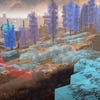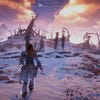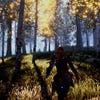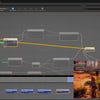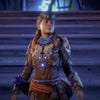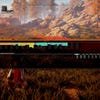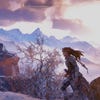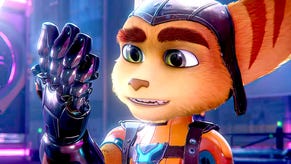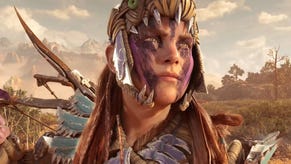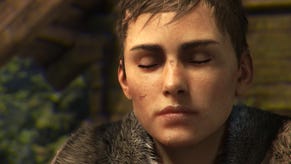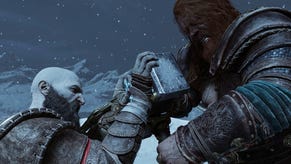Horizon: The Frozen Wilds is an unmissable tech showcase
One of the most impressive 4K HDR experiences you can play.
Horizon Zero Dawn: The Frozen Wilds is an expansion for one of the year's best games in just about every sense of the word. This isn't just more of the same - from a technological standpoint, it's a genuine effort to push on to even greater heights, and an impressive evolution of Guerrilla Games' peerless Decima Engine. Pushing beyond the forests and great plains of the original experience, The Frozen Wilds invites players to the northern-most region of the map to explore snow-covered fields and steep mountains. New features are added to Decima to emphasis the new environments and weather systems, but the core aspects of the technology are just as strong as they ever were: from the gorgeous lighting to the world class HDR implementation and smooth performance, there's little doubt that Horizon remains a beautiful game.
So where does The Frozen Wilds innovate? First and foremost is the debut of new snow deformation technology. While moving through areas packed with deep snow, Aloy and other entities carve up the landscape in a realistic manner, leaving behind lengthy indents in the powder. These trails persist for quite some time after wandering through them as well. This means, following any skirmish, you can even follow the trail of deformation around the battlefield to retrace the fight. Beyond this, as the snow deforms in your wake, grass textures become visible beneath the surface creating the illusion of snow resting atop a once grassy plain.
Even better, as Aloy moves through the snow, her animation is adjusted to match. Her feet realistically kick up snow while pushing through it, while snowy textures are applied to her character model. The result is a convincing sensation of moving through a snowy landscape that was missing in similar areas featured in the original game. This is enhanced further by the snow showers themselves. Often thick, the use of lit snow particles does an excellent job of building just the right atmosphere for each scene.
All of this is complemented by a gorgeous colour palette. The artists have carefully selected just the right combination of colours for every scene - from the pink glow of sunrise to the freezing mountain tops, the depiction of dramatic light and colour is top notch here. Another nice addition to the game can be found in pools of water. While the implementation of screen-space reflections still falls short of expectations, these freezing pools and rivers now feature an interactive icy layer across the surface. As you walk through the water, Aloy leaves trails behind not unlike the snowy landscape. These trails are persistent as well - provided you remain in the general area.
Horizon's landscape is built on procedural rules, and these impact the icy weather conditions too. When faced with an enemy spouting fire and death, layers of ice on water surfaces appears to melt away - an impressive detail. Each of these new features help to enhance the Horizon experience by creating a more interactive and cohesive world, and following a visit to Guerrilla's Amsterdam studio earlier in the year, we now have a stronger sense of how the world of Horizon Zero Dawn works.
First, let's touch on the characters and creatures of the world. The robotic denizens of the world play a key role in defining the look and feel of Horizon and the way in which they engage the player is very important in maintaining this feeling. Each creature is designed to react to Aloy based on a set of pre-defined rules and boundaries. If a distant creature spots the player, it begins to approach to determine if you're a threat. You can then hide from this threat and avoid further conflict.
So how does it know to search for the player and what determines its behaviour? The video on this page visualises the process, but essentially, the enemy has a two-stage vision cone - the first, larger yellow cone represents its alert stage while the red barrier triggers an immediate reaction. If the player hides in long grass, the enemy is forced to search, and if it physically bumps into the player, or spots you within its immediate sphere, it switches to attack mode. This basic logic is applied to different enemies across the world with adjustments made based on the enemy type.
But what makes this more impressive is the pathing logic - the enemies can seamlessly navigate across the terrain while avoiding obstacles, but these obstacles can be adjusted in real-time. If an adjustment is made to the terrain, the AI can dynamically react and avoid this in a realistic manner complete with reaction animations and sound.
So we have some minor insight into how characters and quests might function but what about the visual make-up? Horizon features supremely detailed character models with very high triangle counts and a complex hair and clothing system designed to allow these elements to react naturally to physical movement.
When you break down the model into a wire frame, the sheer level of detail on display becomes evident. All of the characters in Horizon are modelled to an exceptionally high standard, in order to give the developers the freedom to use whichever characters they want at whatever prominence they want. The Frozen Wilds introduces new characters, but variations of older models are also present too.
Then there's the lighting and world itself. It starts with the phenomenal skybox. Guerrilla had a staff member pouring most of his time into studying cloud behaviour and rendering to find the optimal solution. Cloud formations and movement are accurately rendered, to the point where the cost per frame is relatively high - especially when clouds are in full view. However, this cost is carefully factored into Horizon's overall rendering budget.
World lighting is interesting as well. Horizon makes use of pre-calculated global illumination but to make this work with its dynamic time of day system, the engine blends between six different lighting bakes as the day progresses. This is combined with other lighting passes to effectively give the impression of real indirect lighting with moving sunlight. Horizon also uses a multitude of lighting passes in building each scene, starting with emissive or glow lights such as the sky followed by local direct lights such as these torches. This is then followed by the static indirect lighting and sun bounce passes before the sun and sky are rendered. Next are reflections of light across the scenery just before the final texture layer is presented.
Naturally, all of these systems are used in both The Frozen Wilds and the original Horizon experience, since they share the same world and the same core underlying technology. But what's impressive about everything here is how well it all runs. On a PS4 Pro using the high resolution 4K mode, The Frozen Wilds turns in the same generally smooth level of performance as the original release (which has actually improved still further with additional optimisations since we first looked at it). The game simply feels great to play as a result. Horizon is built around an engine hard-coded for 30Hz, but the excellent motion blur implementation really helps here in giving a smooth, consistent experience.
That said, it's not perfect. We tested the expansion on PlayStation 4 Pro and found that when using the high-res mode, there were occasional frame-rate drops. This is where the performance mode comes into play. This was added shortly after launch and lowers the resolution from a checkerboarded 2160p to a native 1368p to secure a more sustained 30fps lock (depth of field and volumetric passes increase in quality too). This mode was designed to add an additional 10 per cent of overhead to the game while pushing native resolution as high as it would go. The general feeling is that this does indeed take care of this sort of drop. Still, when most of the game is already locked at 30fps, our advice would be to stick with the high resolution 2160p mode - though users of 1080p screens may like to try both and see which they prefer.
Whichever way you play, you're in for a treat. The Frozen Wilds reminds us of everything that was great with the original game, while taking both the title in new directions. There's the sense that the artists and designers have been unleashed to create one of the most striking open world environments you can experience. Everything from the density per scene, the choice of colour, the fluidity of the animation and volume of assets really impresses here. We've seen a lot of large, open-ended games this year but it's clear that Guerrilla Games stands at the top of the industry with its efforts. Even with the growing sense of open world fatigue, we found that the world and lore was interesting enough to carry us through the game, while the quality of these visuals and the solidity of the presentation is unparalleled. For us, Horizon Zero Dawn is an essential release - and The Frozen Wilds genuinely adds further to the experience.
You can support Digital Foundry's work and gain access to our entire archive of 1080p, 4K and HDR video by backing us on Patreon for just $5 a month.





